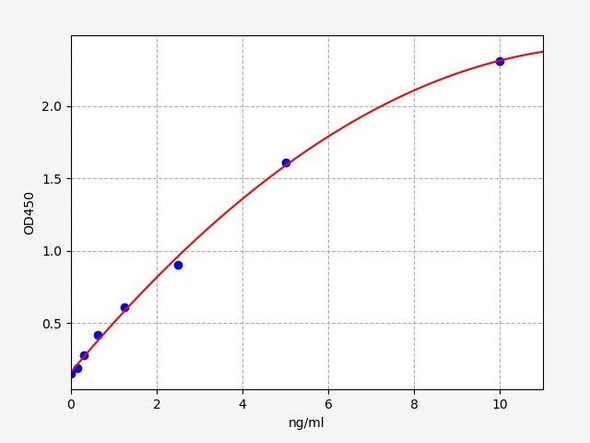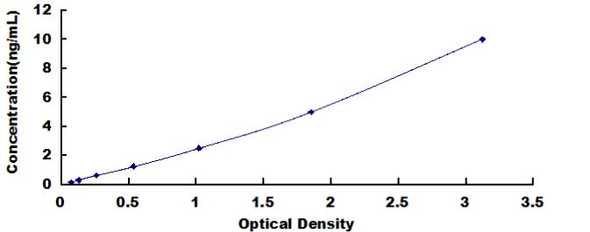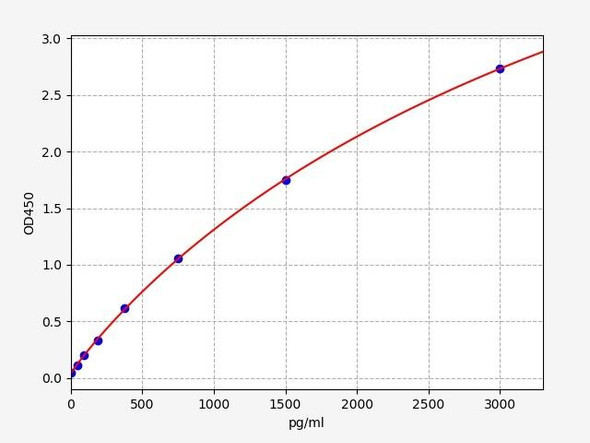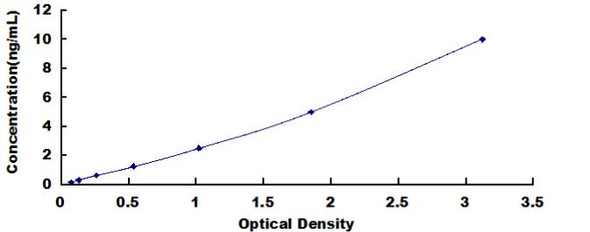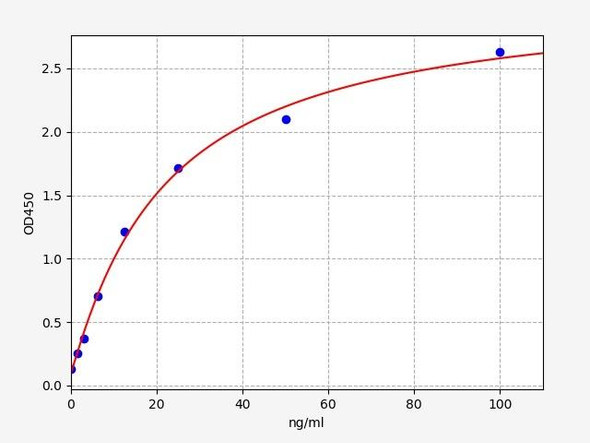Human Cell Biology ELISA Kits 6
Human ATF4 (Activating Transcription Factor 4) ELISA Kit (HUES01720)
- SKU:
- HUES01720
- Product Type:
- ELISA Kit
- Size:
- 96 Assays
- Uniprot:
- P18848
- Sensitivity:
- 0.09ng/mL
- Range:
- 0.16-10ng/mL
- ELISA Type:
- Sandwich
- Synonyms:
- CREB-2, CREB2, TAXREB67, TXREB,TXREB, Tax-Responsive Enhancer Element B67
- Reactivity:
- Human
- Sample Type:
- Serum, plasma and other biological fluids
- Research Area:
- Cell Biology
Description
| Assay type: | Sandwich |
| Format: | 96T |
| Assay time: | 4.5h |
| Reactivity: | Human |
| Detection Method: | Colormetric |
| Detection Range: | 0.16-10 ng/mL |
| Sensitivity: | 0.10 ng/mL |
| Sample Volume Required Per Well: | 100µL |
| Sample Type: | Serum, plasma and other biological fluids |
| Specificity: | This kit recognizes Human ATF4 in samples. No significant cross-reactivity or interference between Human ATF4 and analogues was observed. |
This ELISA kit uses Sandwich-ELISA as the method. The micro ELISA plate provided in this kit has been pre-coated with an antibody specific to Human ATF4. Standards or samples are added to the appropriate micro ELISA plate wells and combined with the specific antibody. Then a biotinylated detection antibody specific for Human ATF4 and Avidin-Horseradish Peroxidase (HRP) conjugate are added to each micro plate well successively and incubated. Free components are washed away. The substrate solution is added to each well. Only those wells that contain Human ATF4, biotinylated detection antibody and Avidin-HRP conjugate will appear blue in color. The enzyme-substrate reaction is terminated by adding Stop Solution and the color turns yellow. The optical density (OD) is measured spectrophotometrically at a wavelength of 450 nm ± 2 nm. The OD value is proportional to the concentration of Human ATF4. The concentration of Human ATF4 in samples can be calculated by comparing the OD of the samples to the standard curve.
| UniProt Protein Function: | ATF-4: a transcription factor that is a member of the leucine zipper family. Isolated and characterized as the cAMP-response element binding protein 2 (CREB-2). Involved in cisplatin resistance. Other members of the family include AP-1 transcription factors, cAMP-response element binding proteins (CREBs) and CREB-like proteins. Two alternatively spliced isoforms have been described. |
| UniProt Protein Details: | Protein type:DNA-binding; Transcription factor Chromosomal Location of Human Ortholog: 22q13. 1 Cellular Component: nucleoplasm; neuron projection; cytoplasm; microtubule organizing center; nucleus Molecular Function:protein C-terminus binding; leucine zipper domain binding; protein binding; DNA binding; protein heterodimerization activity; sequence-specific DNA binding; transcription factor activity Biological Process: amino acid metabolic process; transcription from RNA polymerase II promoter; positive regulation of apoptosis; unfolded protein response; positive regulation of transcription, DNA-dependent; negative regulation of potassium ion transport; positive regulation of transcription from RNA polymerase I promoter; gluconeogenesis; cellular response to glucose starvation; unfolded protein response, activation of signaling protein activity; cellular protein metabolic process; regulation of transcription, DNA-dependent; positive regulation of neuron apoptosis; positive regulation of transcription from RNA polymerase II promoter; circadian regulation of gene expression; gamma-aminobutyric acid signaling pathway |
| NCBI Summary: | This gene encodes a transcription factor that was originally identified as a widely expressed mammalian DNA binding protein that could bind a tax-responsive enhancer element in the LTR of HTLV-1. The encoded protein was also isolated and characterized as the cAMP-response element binding protein 2 (CREB-2). The protein encoded by this gene belongs to a family of DNA-binding proteins that includes the AP-1 family of transcription factors, cAMP-response element binding proteins (CREBs) and CREB-like proteins. These transcription factors share a leucine zipper region that is involved in protein-protein interactions, located C-terminal to a stretch of basic amino acids that functions as a DNA binding domain. Two alternative transcripts encoding the same protein have been described. Two pseudogenes are located on the X chromosome at q28 in a region containing a large inverted duplication. [provided by RefSeq, Sep 2011] |
| UniProt Code: | P18848 |
| NCBI GenInfo Identifier: | 116241262 |
| NCBI Gene ID: | 468 |
| NCBI Accession: | P18848. 3 |
| UniProt Secondary Accession: | P18848,Q9UH31, |
| UniProt Related Accession: | P18848 |
| Molecular Weight: | Calculated Molecular Weight: 38kDaObserved Molecular Weight: 38kDa |
| NCBI Full Name: | Cyclic AMP-dependent transcription factor ATF-4 |
| NCBI Synonym Full Names: | activating transcription factor 4 |
| NCBI Official Symbol: | ATF4 |
| NCBI Official Synonym Symbols: | CREB2; TXREB; CREB-2; TAXREB67 |
| NCBI Protein Information: | cyclic AMP-dependent transcription factor ATF-4; DNA-binding protein TAXREB67; tax-responsive enhancer element B67; cAMP response element-binding protein 2; cAMP-dependent transcription factor ATF-4; cAMP-responsive element-binding protein 2; cyclic AMP-responsive element-binding protein 2; tax-responsive enhancer element-binding protein 67 |
| UniProt Protein Name: | Cyclic AMP-dependent transcription factor ATF-4 |
| UniProt Synonym Protein Names: | Activating transcription factor 4; Cyclic AMP-responsive element-binding protein 2; CREB-2; cAMP-responsive element-binding protein 2; DNA-binding protein TAXREB67; Tax-responsive enhancer element-binding protein 67; TaxREB67 |
| Protein Family: | Cyclic AMP-dependent transcription factor |
| UniProt Gene Name: | ATF4 |
| UniProt Entry Name: | ATF4_HUMAN |
As the OD values of the standard curve may vary according to the conditions of the actual assay performance (e. g. operator, pipetting technique, washing technique or temperature effects), the operator should establish a standard curve for each test. Typical standard curve and data is provided below for reference only.
| Concentration (ng/mL) | O.D | Average | Corrected |
| 10 | 2.453 2.475 | 2.464 | 2.373 |
| 5 | 1.534 1.584 | 1.559 | 1.468 |
| 2.5 | 0.882 0.882 | 0.882 | 0.791 |
| 1.25 | 0.443 0.481 | 0.462 | 0.371 |
| 0.63 | 0.282 0.28 | 0.281 | 0.19 |
| 0.32 | 0.202 0.176 | 0.189 | 0.098 |
| 0.16 | 0.134 0.148 | 0.141 | 0.05 |
| 0 | 0.09 0.092 | 0.091 | -- |
Precision
Intra-assay Precision (Precision within an assay): 3 samples with low, mid range and high level Human ATF4 were tested 20 times on one plate, respectively.
Inter-assay Precision (Precision between assays): 3 samples with low, mid range and high level Human ATF4 were tested on 3 different plates, 20 replicates in each plate.
| Intra-assay Precision | Inter-assay Precision | |||||
| Sample | 1 | 2 | 3 | 1 | 2 | 3 |
| n | 20 | 20 | 20 | 20 | 20 | 20 |
| Mean (ng/mL) | 0.53 | 0.86 | 4.11 | 0.53 | 0.92 | 3.95 |
| Standard deviation | 0.03 | 0.04 | 0.21 | 0.03 | 0.05 | 0.17 |
| C V (%) | 5.66 | 4.65 | 5.11 | 5.66 | 5.43 | 4.30 |
Recovery
The recovery of Human ATF4 spiked at three different levels in samples throughout the range of the assay was evaluated in various matrices.
| Sample Type | Range (%) | Average Recovery (%) |
| Serum (n=5) | 86-101 | 93 |
| EDTA plasma (n=5) | 86-99 | 91 |
| Cell culture media (n=5) | 94-110 | 101 |
Linearity
Samples were spiked with high concentrations of Human ATF4 and diluted with Reference Standard & Sample Diluent to produce samples with values within the range of the assay.
| Serum (n=5) | EDTA plasma (n=5) | Cell culture media (n=5) | ||
| 1:2 | Range (%) | 97-109 | 94-106 | 92-107 |
| Average (%) | 104 | 99 | 98 | |
| 1:4 | Range (%) | 91-103 | 86-101 | 82-94 |
| Average (%) | 97 | 92 | 87 | |
| 1:8 | Range (%) | 91-105 | 84-99 | 88-103 |
| Average (%) | 98 | 90 | 94 | |
| 1:16 | Range (%) | 93-107 | 80-92 | 82-95 |
| Average (%) | 100 | 85 | 89 |
An unopened kit can be stored at 4°C for 1 month. If the kit is not used within 1 month, store the items separately according to the following conditions once the kit is received.
| Item | Specifications | Storage |
| Micro ELISA Plate(Dismountable) | 8 wells ×12 strips | -20°C, 6 months |
| Reference Standard | 2 vials | |
| Concentrated Biotinylated Detection Ab (100×) | 1 vial, 120 µL | |
| Concentrated HRP Conjugate (100×) | 1 vial, 120 µL | -20°C(shading light), 6 months |
| Reference Standard & Sample Diluent | 1 vial, 20 mL | 4°C, 6 months |
| Biotinylated Detection Ab Diluent | 1 vial, 14 mL | |
| HRP Conjugate Diluent | 1 vial, 14 mL | |
| Concentrated Wash Buffer (25×) | 1 vial, 30 mL | |
| Substrate Reagent | 1 vial, 10 mL | 4°C(shading light) |
| Stop Solution | 1 vial, 10 mL | 4°C |
| Plate Sealer | 5 pieces | |
| Product Description | 1 copy | |
| Certificate of Analysis | 1 copy |
- Set standard, test sample and control (zero) wells on the pre-coated plate and record theirpositions. It is recommended to measure each standard and sample in duplicate. Note: addall solutions to the bottom of the plate wells while avoiding contact with the well walls. Ensuresolutions do not foam when adding to the wells.
- Aliquot 100 µL of standard solutions into the standard wells.
- Add 100 µL of Sample / Standard dilution buffer into the control (zero) well.
- Add 100 µL of properly diluted sample (serum, plasma, tissue homogenates and otherbiological fluids) into test sample wells.
- Cover the plate with the sealer provided in the kit and incubate for 90 min at 37 °C.
- Aspirate the liquid from each well, do not wash. Immediately add 100 µL of BiotinylatedDetection Ab working solution to each well. Cover the plate with a plate seal and gently mix. Incubate for 1 hour at 37 °C.
- Aspirate or decant the solution from the plate and add 350 µL of wash buffer to each welland incubate for 1-2 minutes at room temperature. Aspirate the solution from each well andclap the plate on absorbent filter paper to dry. Repeat this process 3 times. Note: a microplatewasher can be used in this step and other wash steps.
- Add 100 µL of HRP Conjugate working solution to each well. Cover with a plate seal andincubate for 30 min at 37 °C.
- Aspirate or decant the solution from each well. Repeat the wash process for five times asconducted in step 7.
- Add 90 µL of Substrate Reagent to each well. Cover with a new plate seal and incubate forapproximately 15 min at 37 °C. Protect the plate from light. Note: the reaction time can beshortened or extended according to the actual color change, but not by more than 30min.
- Add 50 µL of Stop Solution to each well. Note: Adding the stop solution should be done inthe same order as the substrate solution.
- Determine the optical density (OD value) of each well immediately with a microplate readerset at 450 nm.


